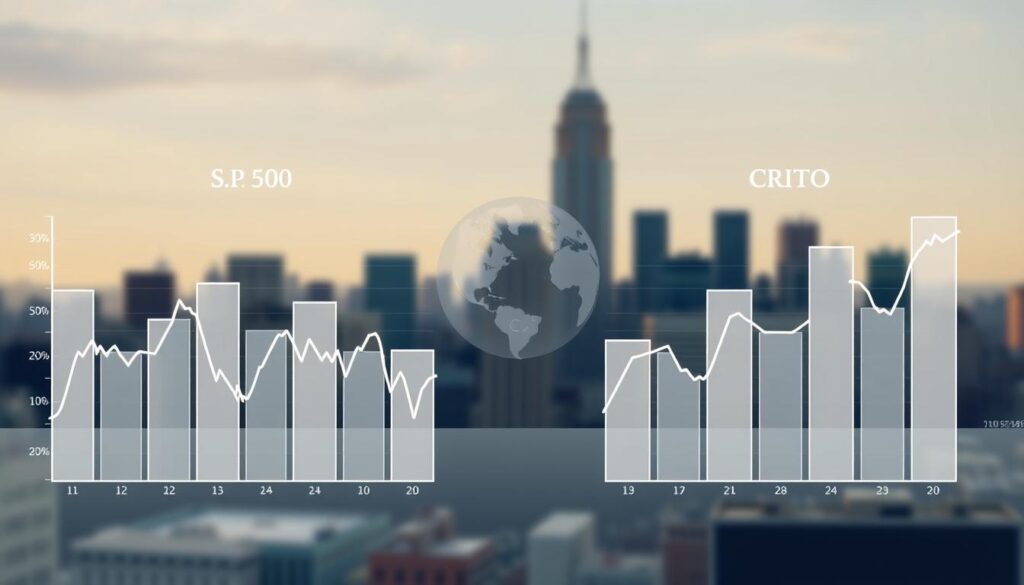Now Reading: Maximize Gains with AI Crypto Portfolio Optimization Strategy
- 01
Maximize Gains with AI Crypto Portfolio Optimization Strategy
Maximize Gains with AI Crypto Portfolio Optimization Strategy

The world of digital assets moves at lightning speed. Traditional investment methods often struggle to keep pace. This is where a new era of management begins.
Advanced technology is now reshaping how we handle digital investments. It processes immense amounts of market data instantly. This allows for decisions based on real-time information, not just gut feelings.
In today’s complex financial landscape, a systematic approach is essential. This guide will walk you through the core principles. You will learn how to build a resilient plan that balances stability with high growth potential.
Our focus is on actionable steps for superior, risk-adjusted returns. We will cover implementation and practical risk management techniques. Get ready to transform your approach to digital asset investing.
Key Takeaways
- Modern technology is revolutionizing how digital asset investments are managed.
- Data-driven decisions are replacing intuition-based approaches for better results.
- A systematic method is crucial for navigating today’s volatile markets.
- This guide provides a clear path from fundamental concepts to practical application.
- Learn to construct a balanced plan that aims for strong, risk-aware performance.
- Real-time data analysis is key to staying ahead in the fast-moving digital asset space.
Introduction: The Evolution of Crypto Portfolio Management
The financial world has witnessed a seismic shift with cryptocurrencies evolving from niche assets to core holdings. Traditional approaches struggle to keep pace with this dynamic landscape.
The Need for AI in Modern Investment
Human traders face significant challenges in today’s markets. Emotional biases like FOMO and panic selling often lead to poor decisions. The global nature of digital asset markets operates 24/7, making continuous monitoring impossible for individuals.
Automated systems overcome these limitations by removing emotional factors from the equation. They can process information instantly and operate around the clock.
How Data and Analytics Transform Trading
Modern trading relies on processing massive datasets in real-time. This includes price movements, volume metrics, and market sentiment analysis. Advanced analytics provide actionable insights that human traders might miss.
These systems empower investors to make data-driven decisions rather than relying on intuition. The result is more consistent performance and better risk management.
| Capability | Human Trading | Automated Systems |
|---|---|---|
| Market Monitoring | Limited hours | 24/7 operation |
| Data Processing | Manual analysis | Real-time processing |
| Emotional Influence | High susceptibility | Zero emotional bias |
| Reaction Speed | Seconds to minutes | Milliseconds |
| Decision Basis | Intuition and experience | Statistical analysis |
This evolution represents a necessary adaptation to handle modern market complexity. Investors now have tools that were unimaginable just a decade ago.
Fundamentals of Portfolio Optimization: Traditional vs. Crypto Indices
For decades, investors have relied on established models to build their financial holdings. The classic 60/40 mix, dividing assets between stocks and bonds, has long been a cornerstone. This approach aimed for steady growth with managed risk.
Understanding the 60/40 Baseline and Its Challenges
The traditional 60/40 allocation delivered about 7.2% annual returns over twenty years. However, this model faces new hurdles today. Low bond yields and high stock valuations reduce its effectiveness.
Increased correlation between stocks and bonds also weakens its diversification power. This means both asset classes might fall together during market stress.

Crypto Indices Performance: A Comparative Overview
Modern digital asset indices present a different performance profile. Token Metrics indices, for example, show significantly higher risk-adjusted returns. Their Sharpe ratios are substantially greater than traditional models.
The following table highlights the key differences in performance metrics.
| Index Type | Avg. Annual Return | Sharpe Ratio |
|---|---|---|
| 60/40 Portfolio | 7.2% | 0.48 |
| S&P 500 | 9.7% | 0.54 |
| Token Metrics Value Index | 86% | 1.68 |
| Token Metrics Balanced Index | 104% | 1.87 |
These indices show low correlation to traditional markets. This provides a powerful diversification benefit. Even a small allocation can improve a financial plan’s overall efficiency.
This enhancement can potentially double expected gains with only a minor increase in volatility. Digital indices act as powerful complements, not replacements, for conventional assets.
Implementing the AI Crypto Portfolio Optimization Strategy
The journey toward a more effective asset management system begins with a personal financial review. This initial assessment is the bedrock of a sound plan. You must understand your current holdings, risk comfort level, and long-term goals.
This clarity allows you to determine the right digital asset allocation for your situation.

Step-by-Step Guide to Getting Started
Follow this straightforward process to build a robust financial plan. First, conduct a thorough review of your existing investments and risk tolerance. This research forms the basis for all subsequent decisions.
Next, select your allocation percentage based on your investor profile. Conservative individuals might start with a small 5% allocation. Moderate participants could aim for 15%, while aggressive investors may target up to 25%.
Choosing the right platforms and tools is critical. Look for proven indices that use advanced data analysis. These systems offer built-in diversification and regular rebalancing, which is a key part of the optimization process.
A popular framework is the core-satellite model. It suggests keeping 70-80% of assets in traditional holdings for stability. The remaining 20-30% is allocated to growth-oriented digital indices. This strategy balances security with potential for higher returns.
Finally, establish a schedule for review, such as quarterly or semi-annually. Continuous monitoring allows for adjustments as markets evolve. Consulting with a knowledgeable financial professional can also provide valuable guidance, especially for tax-related matters.
Harnessing Data-Driven Insights for Smarter Investment Decisions
Modern investment tools rely on predictive power to navigate complex markets. This power comes from machine learning, which forms the backbone of contemporary analysis.
These systems process immense datasets to forecast trends with remarkable accuracy.

Leveraging Machine Learning for Predictive Analytics
Sophisticated models analyze information to identify patterns. Recurrent neural networks, support vector machines, and random forests are commonly used.
Each model is designed to find complex correlations within massive amounts of data.
The inputs for these systems are incredibly diverse. They include historical prices, trading volumes, and on-chain metrics. They also process order book data and broader economic indicators.
By integrating these sources, a holistic view of market conditions emerges. This integration allows for faster, more objective insights.
| Machine Learning Model | Primary Function | Key Data Inputs |
|---|---|---|
| Recurrent Neural Networks (RNNs) | Analyze time-series data sequences | Historical price trends, volume patterns |
| Support Vector Machines (SVMs) | Classify data for trend identification | Market sentiment signals, price levels |
| Random Forests | Handle complex, non-linear relationships | On-chain metrics, macroeconomic factors |
The result is a significant reduction in human bias. Data-driven decisions replace emotional reactions, making it easier to spot opportunities.
This analytical approach empowers investors to act with greater confidence. It is a critical advantage in today’s fast-paced financial landscape.
Navigating Market Volatility with Advanced Risk Management
Managing volatility is the cornerstone of successful long-term participation in rapidly changing financial environments. Sophisticated approaches help investors protect their holdings during turbulent periods.

Mitigating Risks Through Diversification
Diversification remains a fundamental protection strategy against market turbulence. Modern systems recommend spreading exposure across various digital assets and sectors.
This approach reduces concentration risk and helps manage volatility. Built-in diversification through index-based solutions provides balanced exposure.
Effective Rebalancing in a Dynamic Crypto Market
Regular adjustments are essential for maintaining target risk levels. Automated systems monitor portfolio drift and make timely changes.
Rebalancing captures gains from outperforming assets while managing overall exposure. This process responds effectively to changing market conditions.
Advanced tools also simulate performance under various scenarios. This stress testing helps investors understand potential vulnerabilities before they occur.
AI-Powered Trading: Overcoming Human Limitations
Cognitive limitations create persistent challenges for participants in volatile markets. Even experienced traders struggle with psychological factors that cloud judgment during critical moments.
These inherent human constraints make consistent success difficult to achieve. Modern tools offer solutions to bridge this capability gap.
Addressing Cognitive Biases and Emotional Trading
Fear and greed often drive poor trading decisions at the worst possible times. The fear of missing out pushes people to buy during price peaks. Panic selling during downturns locks in unnecessary losses.
Confirmation bias causes traders to seek information supporting their existing views. They may ignore contradictory evidence that suggests a different approach. This selective perception undermines objective analysis.
The global nature of digital markets presents additional challenges. Human traders cannot monitor activity across all time zones continuously. They lack the processing capacity to analyze massive datasets in real-time.
| Human Limitation | Impact on Trading | Automated Solution |
|---|---|---|
| Emotional reactions | Impulsive buying/selling | Rule-based execution |
| Cognitive biases | Selective data interpretation | Comprehensive analysis |
| 24/7 monitoring | Missed opportunities | Continuous operation |
| Data processing | Slow decision-making | Instant analysis |
Sentiment analysis tools scan social media and news sources to gauge market mood. Advanced algorithms detect emotional tones in public discussions. This provides valuable context beyond pure numerical data.
These systems complement human judgment rather than replace it entirely. They address inherent limitations while allowing strategic oversight. The result is more rational, data-informed decisions.
Unlocking Opportunities: Real-World Examples and Insights
Moving beyond theory, real-world performance data offers a clear window into potential outcomes. These insights demonstrate the practical application of advanced methodologies.
They show how systematic approaches can lead to significant results.
Case Studies Highlighting Token Metrics Performance
Since 2020, several flagship indices have delivered impressive track records. They cater to different investor profiles, from conservative to aggressive.
The Value Investor Index focuses on strong fundamental assets. It achieved an 86% average annual return.
This example shows even cautious digital asset strategies can outperform traditional models.
The Balanced Investor Index combines different analyses for moderate risk. It posted a 104% annual return, offering growth with managed volatility.
For those seeking higher gains, the Momentum Trader Index captured 147% annual returns. This illustrates the substantial opportunities available.
Consider a $100,000 investment over five years. A traditional 60/40 mix might grow to around $141,478.
The indices discussed could potentially achieve multiples of that return. This represents a powerful wealth-building chance.
| Index Name | Annual Return | Sharpe Ratio | Investor Profile |
|---|---|---|---|
| Value Investor Index | 86% | 1.68 | Conservative |
| Balanced Investor Index | 104% | 1.87 | Moderate |
| Momentum Trader Index | 147% | 2.09 | Aggressive |
Current market developments also present compelling insights. Solana has shown remarkable growth since its launch.
Major financial institutions are integrating digital assets into their services. This signals growing mainstream acceptance.
A survey found that 60% of institutional investors plan to increase their allocation. This trend validates the long-term viability of this asset class.
Using tools that provide real-time AI grades for crypto trading can help investors capitalize on these opportunities. The evidence confirms that data-driven management is a proven path to superior returns.
Strategic Allocation: Balancing Traditional Assets and Digital Investments
A well-structured financial plan is the bedrock of long-term wealth creation. It involves carefully mixing different types of holdings to achieve specific goals. This approach balances stability with growth potential.
One increasingly popular framework is the core-satellite model. It helps investors manage risk while seeking strong performance.
Implementing a Core-Satellite Model for Optimal Returns
The core part, making up 70-80% of the plan, consists of traditional assets like stocks and bonds. This foundation provides steady, predictable growth. It acts as a cushion during market downturns.
The satellite portion, typically 20-30%, is allocated to dynamic digital indices. This segment aims for accelerated growth. It captures upside during strong market cycles.
This structure offers the best of both worlds. The core ensures stability, while the satellite drives higher returns. It is a key part of effective crypto portfolio management.
Allocations should match an individual’s risk profile. Conservative investors might start with a 5% satellite allocation. Moderate participants could aim for 10-15%, while aggressive investors may target 20-25%.
The most resilient plans for 2025 combine traditional and digital assets. This balanced approach is designed for superior long-term outcomes.
Integrating AI with Crypto Trading Platforms: Best Practices
Modern trading environments demand sophisticated solutions that combine real-time data processing with intelligent decision support. The right integration can transform how you approach market participation.
Choosing the Right AI-Driven Trading Tool
Selecting analytical platforms requires careful evaluation. Consider data quality, algorithm transparency, and security protocols. User-friendly interfaces make complex analysis accessible.
Platforms like Powerdrill Bloom demonstrate this approach effectively. They process exchange data and identify price patterns automatically. This saves time on manual research.
Look for tools that integrate sentiment analysis from news sources. The best platforms provide clear recommendations based on comprehensive market data.
Optimizing Workflow for Enhanced Decision-Making
Establish automated alerts for specific market conditions. Schedule regular portfolio reviews generated by your chosen tools. This creates a disciplined process.
Combine algorithmic recommendations with personal judgment. Start with small allocations to test different platforms. Monitor performance metrics continuously.
Effective integration is an ongoing refinement process. It balances automated capabilities with strategic human oversight for optimal results in dynamic markets.
Conclusion
The future of wealth building now hinges on blending time-tested methods with cutting-edge technology. This hybrid approach creates resilient financial plans that withstand market fluctuations while capturing growth potential.
The most successful investors combine traditional stability with modern digital opportunities. This balanced methodology provides flexibility to adapt to changing global conditions. It represents an enhancement rather than replacement of established practices.
A structured process begins with personal assessment and allocation planning. Regular monitoring and adjustments ensure alignment with evolving market dynamics. Professional guidance helps navigate complex factors like tax considerations.
Advanced analytical tools process massive datasets to identify patterns and opportunities. These systems provide valuable insights while reducing emotional decision-making. The optimal approach combines technological capabilities with human oversight.
Embracing this evolution positions participants to navigate challenges effectively. It creates a pathway to superior results in today’s dynamic investment environment.
FAQ
What is the primary advantage of using machine learning for managing digital asset investments?
The main benefit is the ability to process vast amounts of market data and news in real-time. This enables the identification of complex patterns and trends that are difficult for humans to spot, leading to more informed and timely investment decisions.
How does this approach help manage risk in such a volatile environment?
Advanced analytics tools assess various risk factors and market conditions continuously. They provide recommendations for diversification and automatic rebalancing, which helps mitigate potential losses during sudden price swings and adapts to changing market dynamics.
Can I use these tools if I’m new to trading?
Yes, many platforms are designed with user-friendly interfaces that simplify the process. They offer clear insights and actionable recommendations, making sophisticated investment strategies accessible to both novice and experienced traders without requiring deep technical research.
What kind of data do these systems analyze to generate insights?
They analyze a wide range of information, including real-time price movements, trading volumes across major exchanges, social media sentiment, and broader financial market news. This comprehensive data processing helps uncover hidden opportunities.
How often should I rebalance my holdings using an automated strategy?
Rebalancing is not based on a fixed schedule but on live market conditions. The system continuously monitors your assets and will suggest or execute adjustments whenever it identifies a significant shift that aligns with your predefined investment goals and risk tolerance.
Are there any significant challenges with relying on automated decision-making?
A key challenge is ensuring the underlying algorithms are robust and regularly updated to reflect current market behaviors. Investors should choose reputable platforms with proven track records and maintain a level of oversight to ensure the strategy aligns with their long-term objectives.














